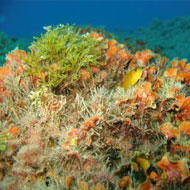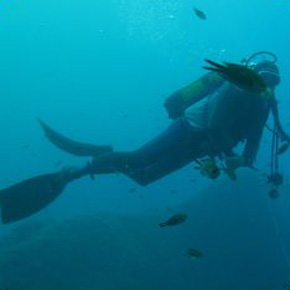The sea
Ambiente Marino

The marine ecosystem
The Protected Marine Area of the Portovenere Regional Nature Park includes the southwestern part of Palmaria Island, the islands of Tino and Tinetto, and the Posidonia meadowland located in the channel that separates Portovenere from Palmaria Island. Characterized by a variety of environments such as shallows, caves and sheer cliffs, it provides underwater enthusiasts with thrilling opportunities to admire fascinating, brightly colored and differently-shaped specimens of sea life. The area’s gorgonians, typical coralligenous organisms, are especially extraordinary: one can see the genus Eunicella, the species Paramuricea clavata, known as the red gorgonian, and Leptogorgia sarmentosa, in shallower waters than elsewhere. There are numerous caves, too, many of which are under as well as above water. The underwater cave of Tinetto is unique among these: stunningly beautiful, it has a crack which allows the sunlight to get in, creating striking light effects that can turn a dive into a memorable experience. The Blue Cave on Palmaria Island boasts amazing natural lighting, too, while the Tino Cave, and the famous grotto named after Lord Byron located behind Punta San Pietro in Portovenere, albeit not part of the Protected Marine Area, both deserve to be noted for their rich and wonderful seabeds.
The Protected Marine Area of the Portovenere Regional Nature Park also houses a Posidonia meadow. Although small, this represents an extremely important environment both for the organisms that live in it and because it is a natural barrier against waves and currents, hence offering excellent protection against coastal erosion. The ecosystem of this Posidonia meadow is so unique that it has been included in the 92/43/EEC (known as the Habitats Directive) on fostering and preserving natural habitats in EC countries. The abundance and variety of creatures that live among the leaves of these plants is nothing short of incredible: salps, bogue, sea urchins, algae, wrasses, camouflage needlefish, seahorses, tiny shellfish, mollusks, and starfish, too. The Protected Marine Area of Portovenere comprises our Posidonia meadow, ensuring it is constantly monitored, protected, and safeguarded. This area is a gem of remarkable beauty immersed in an evocative landscape and typified by diverse and distinctive traits that make it unforgettable to all who visit.
Siti di immersione dell’Area di Tutela Marina di Porto venere

Dive sites in the Protected Marine Area of the Portovenere Regional Nature Park
The underwater world of the Protected Marine Area of the Portovenere Regional Nature Park is home to an enthralling, fascinating, and diverse variety of forms of life… divers are always thrilled! Gorgonians, rocks tinged with the vivid colors of colonizing sponges, walls bedecked with yellow cluster anemones (Parazoanthus axinellae), dancing fish, lobsters, moray eels, and conger eels emerging from their hiding places. Plus, the rich and unpredictable world that lives in and with the Posidonia oceanica. All this creates an incredibly beautiful underwater ecosystem. The three islands, Palmaria, Tino, and Tinetto, on the other hand, are endowed with a peculiar morphological structure of sheer partially submerged cliffs that create evocative environments particularly appreciated by those who practice scuba diving. Over time, the sea’s incessant movement has shaped submerged and semi-submerged karst caves: these allow underwater speleologists to venture into more or less difficult tunnels, enjoy amazing light effects and admire forms of life that are typical of semi-dark environments. The Protected Marine Area also comprises a Posidonia oceanica meadow – S.I.C IT1345104 – which is included in Annex 1 of the Habitats Directive 92/43/EEC. It’s a uniquely lively habitat where wrasses, salps, prairie bream, sea urchins, starfish, seahorses, and needlefish find the shelter and food they need. The Posidonia meadow is also important for its role in defending the coast from the erosive action of the sea; in fact, its leaf mass creates a natural barrier that protects the coast and beaches, reducing the otherwise destructive force of the sea.
Rich in colors and submerged wonders, this unique area is a precious treasure for all those who love and cherish the sea, and who wish to discover a diverse marine environment. The Protected Marine Area was established to ensure the protection, and safeguarding of the animal and plant species present, and to promote knowledge and correct, conscious enjoyment of this environment.